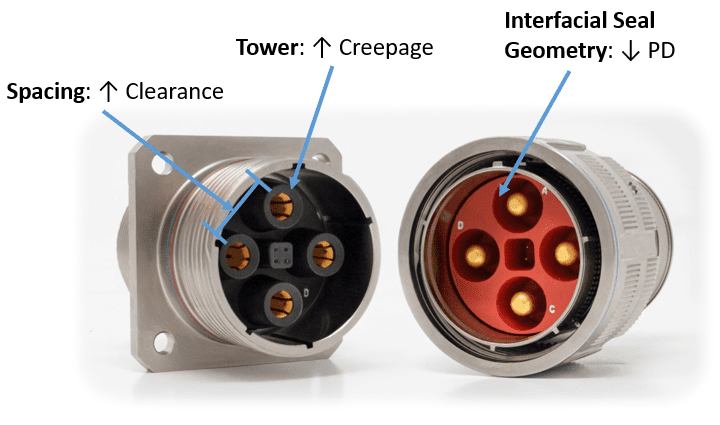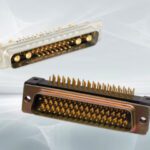Connector Suppliers Join the Electric Era of Aviation
EV technologies now extend to electric aircraft. Connector designers are developing the lightweight, powerful, and rugged interconnects needed for this new industry to take flight.

Canada’s Harbour Air, North America’s largest seaplane airline, and Australian engineering firm magniX, specializing in all-electric propulsion, have developed the world’s first all-electric commercial aircraft. The plane, a six-passenger DHC-2 de Havilland Beaver magnified by a 750-horsepower (560 kW) magni500 propulsion system, had its first successful flight in 2019 on the Fraser River at Harbour Air Seaplanes terminal in Vancouver. Roei Ganzarski, CEO of magniX, referred to the event as the launch of the electric era of aviation. Since then, the plane has completed over 30 test flights and the company has begun work on a second plane.
As with many of today’s industries, the aircraft industry is tasked with mitigating its negative impact on climate change by lowering carbon emissions while also reducing air and noise pollution. Aircraft manufacturers and suppliers are constantly looking for ways to optimize performance and reliability while lowering operating and maintenance costs. Moving away from fossil fuels and incorporating electric systems for primary power and control solves many of the issues that plague modern aircraft. However, this change brings some challenges as well.
The concept of aircraft electrification has been around since World War II, but it is getting more attention today as demand increases and progress accelerates. More electric aircraft, or MEA, is the term used for hybrid aircraft that use electric power for non-propulsive systems. Traditionally, pneumatic, hydraulic, mechanical, and electric secondary power sources are what drive these systems. According to AMETEK Engineered Interconnect and Packaging (EIP), newer aircraft are changing from those systems to electric, no bleed systems that include condition-based monitoring. AMETEK’s SEALTRON brand is currently developing connectors that can handle extreme temperatures (closer to the aircraft engine), higher current carrying capacity (for power delivered from lithium polymer battery systems) and lighter weight (by incorporating aluminum shells). Its HERMETIC SEAL brand manufactures hermetic glass sealed connectors, an essential component for more electric and all electric aircraft wiring and electronic systems. The connectors are installed on power supplies, actuation devices, and sensors to aid in conveying power and electronic signals on the airframe.
In the quest to convert primary power systems and control systems to fully electric, a combination of higher currents and increased voltages, while managing the resulting trade-offs, will be necessary, explained Sean Herman, design applications engineer with Amphenol Commercial Air Division. Using higher currents results in greater temperature rise, which necessitates a move to larger conductors. While full aircraft electrification mandates some growing conductor sizes, especially when dealing with primary power systems, aircraft manufacturers do their best to limit increases in conductor diameters because of the resulting increase in weight, which Herman acknowledges is a deal breaker for this industry. “It’s worth noting that increased temperature associated with higher currents also negatively impacts general electrical efficiency. The use of aluminum conductors has been explored for weight savings, but there are challenges to consider when going down that road as well,” he added.
Herman further explained that to facilitate the increased power required in this new style of aircraft, increases can be made to the system voltage in addition to the current. Choosing this direction does have its downsides, however, including electrical breakdown and shortened connector life, which must be subsequently addressed. The overall effect of the voltage increases on wire itself is minimized as conductors are generally insulated individually; thickness and material can be modified without radically changing the product. However, when looking at connectors, the mating interfaces between plug and receptacle are often relatively susceptible. For example, the D38999 series III connector interface shown below has a relatively uniform interface. There is not much distance between contacts either across the surface (creepage) or through the air (clearance).

The Amphenol Aerospace D38999 series III connector interface has little distance between contacts.
To combat this, the insulator material can be improved or the geometry can be changed. The HV38999 connector from Amphenol Commercial Air Division, depicted below, has a completely redesigned insert utilizing an insulator material with improved electric properties (increased dielectric strength) as well as optimized conductor spacing and towers to add further separation. Partial discharge, a negative voltage effect at altitude which can reduce the life cycle of the connector, is another phenomenon which must be carefully designed around to avoid premature degradation.

The HV38999 connector from Amphenol Commercial Air Division demonstrates improved electric properties (increased dielectric strength) as well as optimized conductor spacing and towers to add further separation.
Small aircraft, including AAM (advanced air mobility) airframes, eVTOL (electric vertical takeoff and landing), and eSTOL (electric short takeoff and landing) aircraft, are playing an important role in the advancement of aircraft electrification. Connector suppliers are finding ways to address issues of power as well as other in-flight needs, such as infotainment, with design improvements and material changes that address weight and space restrictions, reliability, and harsh environment (i.e., temperature changes and resistance to shock and vibration).
To learn more about companies mentioned in this article, visit the Preferred Supplier pages for Sealtron and Amphenol Aerospace.
Like this article? Check out our other Commercial Aviation and EVs and HEVs articles, our Mil/Aero Industry articles, and 2022 Article Archives.
Subscribe to our weekly e-newsletters, follow us on LinkedIn, Twitter, and Facebook, and check out our eBook archives for more applicable, expert-informed connectivity content.
- Sealing Success: Overmolding for More Secure Connections - April 23, 2024
- Medical Cable Assemblies Product Roundup - April 23, 2024
- Mezzanine Connectors Product Roundup - April 16, 2024





